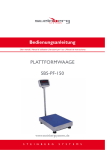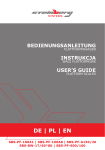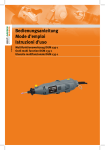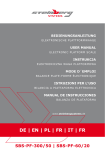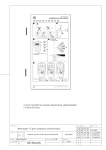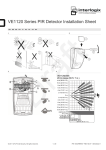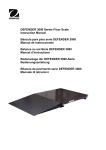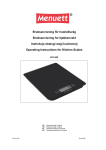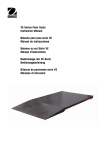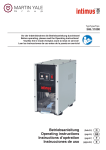Download DE - JG Gastro - największy sklep dla gastronomii w Polsce
Transcript
BEDIENUNGSANLEITUNG BODENWAAGEN USER MANUAL PLATFORM SCALES MANUEL D‘UTILISATION BALANCES PLATEFORMES ISTRUZIONI PER L`USO BILANCE A PLATTAFORMA MANUAL DE INSTRUCCIONES BALANZAS CON PLATAFORMAS INSTRUKCJA OBSŁUGI WAGI PLATFORMOWE DE | EN | FR | IT | ES | PL SBS-BW-3T | SBS-BW-5T | SBS-BW-1T SBS-BW-3T/1KG | SBS-BW-5T/2KG INHALT | CONTENT |CONTENU |CONTENUTO | CONTENIDO | TREŚĆ ALLGEMEINE INFORMATIONEN WARNUNGEN UND HINWEISE Elektronisches Wiegen ist ein präzises Messverfahren. Die Sicherheit sollte jedoch an vorderster Stelle stehen. Bitte beachten Sie die folgenden Hinweise, um die Lebensdauer Ihrer Plattformwaage zu erhöhen und einen korrekten Betriebszustand zu gewährleisten: 3 • Plattformwaagen besitzen einen Überlastbereich. Meiden Sie den Überlastbereich, um Beschädigungen am Sensor und an der Waage und den Garantieverlust zu vermeiden. (die Waage gibt bis 135% Überlast Warnsignale aus) • Achten Sie auf einen stabilen Halt der Lasten. • Überprüfen Sie den Sitz aller Schrauben, Füße und der Haltestange. • Vermeiden Sie das Messen bei zu höher Feuchtigkeit und unter Regen. • Vermeiden Sie das Arbeiten bei hohen Umgebungstemperaturen. • Laden Sie mindestens einmal alle 2 ~ 3 Monate die Batterie 24 h auf, um die max. Kapazität und eine hohe Lebensdauer zu gewährleisten sowie Entladungen zu vermeiden. Lesen Sie bitte vor der Inbetriebnahme die Betriebsanleitung durch! 8 14 20 26 32 TECHNISCHE DETAILS Modell SBS-BW-3T SBS-BW-5T SBS-BW-1T Messbereich Einteilung Eigengewicht Fläche bis 3000 kg 1 kg 119 kg 150 cm | 150 cm bis 5000 kg 2 kg 151 kg 150 cm | 150 cm bis 1000 kg 500 g 79 kg 100 cm | 100 cm Halten Tarieren Nullieren Funktionen Display Versandgewicht Versandmaße (LxBxH) 2 123 kg 152x152x 19 cm SBS-BW3T/1KG bis 3000 kg 1 kg 57 kg 100 cm | 100 cm Stückzählung Wechsel der Gewichtseinheiten (kg/lb) PACK LCD 156 kg 81,5 kg 58 kg SBS-BW5T/2KG bis 5000 kg 2 kg 82 kg 100 cm | 100 cm 83 kg 152 x 152 x 101 x 101 x 102 x 102 x 102 x 102 x 19 cm 9 cm 9 cm 9 cm 3 DE FUNKTIONEN DES FRONTPANELS WARN- UND ZUSTANDSIGNALE Batteriezustand (lb) Erscheint auf dem Display eine LB -Anzeige und gleichzeitig ertönt ein BEEP -Ton, so bleiben Ihnen ungefähr ~ 1 h Restdauer. Schalten Sie die Waage an das Netz an. Ist die Waage an das Netz angeschlossen, schaltet sich die Anzeige sowie das Warnsignal ab und die AC -Diode leuchtet auf. Um die Batterie vollständig aufzuladen, sollten sie die Waage 4 h aufladen. X SICHERHEITSANZEIGE Status „NO“ Wenn „NO“ auf dem Display erscheint, arbeitet der elektrische Stromkreis nicht. Die Waage muss repariert werden. BEDIENFELDER UND EINSTELLUNGEN EIN-/AUSSCHALTEN (I/O) DE Mit der I/O - Hauptschalter auf der Rückseite wird die Waage angeschaltet und der Selbsttest wird gestartet. Der Selbsttest beginnt mit dem Display- und Diodentest. Es müssen die 0.0.0.0.0.0 -Anzeige auf dem Display sowie alle Dioden korrekt aufleuchten. Anschließend folgen Informationen über die aktuelle Kalibrierungseinstellung (werkseitig 0150.05 -Anzeige ,d.h. 150 kg Messbereich in 0,5 kg Intervallabstand), die Programmversion des Taschenrechners (Uer_3.2 -Anzeige, d.h.Ver. 3.2) und über den Betriebsspannungszustand (z. B. dC_U5.0 für 5.0 V). Nach dem Test ist die Waage betriebsbereit mit der 0.00 -Anzeige. Drücken Sie erneut den I/O - Hauptschalter um die Waage auszuschalten. Bei dem Modell SBS-BW-3T/1KG ist der Kopf mit der Plattform kabellos verbunden. Die Kommunikation zwischen der Plattform und dem Kopf wird nach dem Einschalten des Kopfes und der Plattform aufgenommen. Die Plattform wurde mit 3 Kontrollleuchten ausgestattet: leuchten, um einen korrekten Betriebszustand zu gewährleisten. Wenn die ZERO -Diode nicht leuchtet oder die Anzeige sich nach der Entlastung nicht auf Null zurücksetzt, dann drücken Sie kurz die [ZERO/TARE] -Taste. Die Waage bestätigt die Null-Nivellierung mit der 0.00 -Anzeige. Anschließend können Sie das Nettogewicht messen. FEHLERMELDUNGEN “ Ad_Err ” “Lo_bat” ---OL--- Overload. SEtErr Das Gewicht wird vom Sensor nicht gemessen. Reparaturfall. Batterie ersetzen. Zu viel Gewicht auf der Waage. Die Daten sind nicht korrekt. Reparaturfall. DRÜCKEN SIE NICHT DIE [ZERO/TARE] -Taste, solange die Last nicht stabil hängt (zu erkennen am unteren linken Rand des Displays an der STABLE -Diode, die nicht leuchtet), um Messfehler zu vermeiden. NULL-NIVELLIEREN (ZERO) Vor dem Null-Nivellieren legen Sie den leeren Behälter auf die Plattform, wenn die STABLE -Diode leuchtet. Drücken Sie anschließend kurz die [ZERO/TARE]-Taste, damit die Waage das Leergewicht des Behälters ignoriert. ACHTUNG Nach der Null-Nivellierung reduziert sich die max. messbare Last um das entsprechende Leergewicht des Behälters! z. B. Behälter b = 90kg, max. Last l = 150kg, max. noch messbare Last L: L = l – b = 60 kg. Legen Sie die Last langsam auf die Plattform und entfernen Sie diese sofort bei Überlast (zu erkennen an der OL -Anzeige auf dem Display). AC – bedeutet Aufladevorgang des Akkus (AC Versorgung ist angeschlossen) HALTEN (HOLD) Low Voltage – bedeutet, dass man den Akku der Plattform aufladen soll. Bei einem Lastwert ≥0,05 kg im Wägemodus kann der Haltemodus aktiviert werden, indem Sie die goldene [HOLD] -Taste drücken. Gleichzeitig leuchtet zur Bestätigung die HOLD -Diode am rechten unteren Rand des Displays auf. Drücken Sie anschließend nochmal die [HOLD]-Taste, um den Haltemodus zu verlassen und in den Wägemodus zurückzukehren. SIGNAL – nach einer korrekten Verbindung zwischen Plattform und Kopf wird die Leuchte blinken. Falls am Display folgende Meldung angezeigt wird: „Err24” bedeutet es, dass es ein Fehler in der kabellosen Verbindung zwischen dem Kopf und der Plattform aufgetreten ist (die Plattform ist ausgeschaltet oder ihr Akku muss aufgeladen werden). ZURÜCKSETZEN (TARE) Bevor Sie die Last auflegen, vergewissern Sie sich, dass die ZERO -Diode, die STABLE -Diode am linken Displayrand und die gewünschte Einheit am rechten Displayrand 4 EINHEITENWECHSEL (UNIT / KG / LB, LB / KG) Mit der [UNIT] -Taste können Sie zwischen der kg- und lb -Einheit wechseln. Drücken Sie dafür kurz die [UNIT]-Taste, bis Sie die gewünschte Einheit ausgewählt haben. 5 DE PACK - FUNKTION: Es gibt zwei Auswahlmöglichkeiten in der Funktion PACK: IN und OUT. In den Standardeinstellungen sind die Funktionen PACK, sowie ALARM ausgeschaltet (die Einstellung „NO“). Wenn „IN“ eingestellt ist, wird das Gerät mit Alarm signalisieren, falls sich das Gewicht zwischen UPPER (OBEREM) und LOWER (UNTEREM) Limit befindet; wenn „OUT“ eingestellt wird, schaltet der Alarm ein, im Moment, wenn das obere oder untere Limit überschritten wird. Das Display zeigt HHHHHH, falls das obere Limit überschritten wird, und LLLLLL, falls das untere Limit überschritten wird. WIE STELLT MAN IN EIN Die Waage mit dem Mustergewicht (z. B. 1000,0 kg) belasten, dann die Taste PACK drücken, bis auf dem Display SET-AL erscheint; in diesem Moment gelangt die Waage in den Funktionsauswahlmodus. Mit Hilfe der Tasten +/- IN wählen. [ZERO/TARE] drücken, um zu bestätigen und in nächste Einstellung zu gelangen; auf dem Display wird AL-UP angezeigt – in diesem Moment soll man LOWER das (UNTERE) Limit einstellen (z. B. 995,0 kg eintragen). ZERO/TARE drücken, um zu bestätigen, und in nächste Einstellung zu gelangen; das Display zeigt AL-DN und man soll UPPER das (OBERE) Limit (z. B. 1005,0 kg) eintragen. [ZERO/TARE] drücken, um zu bestätigen, das Display wird IN anzeigen. Das heißt, dass die Einstellungen beendet wurden. DE ACHTUNG: der Bereich [IN] zwischen 1000,0kg±5,0kg ist ein Beispiel. WIE STELLT MAN UPPER/LOWER DAS (OBERE/UNTERE) LIMIT EIN Mit Hilfe der Tasten [UNIT] und [HOLD] kann man das obere und untere Limit einstellen, indem man die Ziffer 0-9 einträgt. Drücken Sie [UNIT], um den Wert zu steigern und [HOLD], um den Wert zu mindern. Drücken Sie [ZERO/TARE], um zu bestätigen und von den Einstellungen herauszukommen. EINSTELLEN DES ALARMS Überschreiten des unteren Limits (995,0kg), wird mit einem Ton und der Meldung (LLLLLL), die auf dem Display angezeigt wird, signalisiert. Das Überschreiten des oberen Limits wird mit deinem Ton und der Meldung (HHHHHH), die auf dem Display angezeigt wird, signalisiert. STÜCKZÄHLUNG Bestimmung des mittleren Gewichts eines Probestückes: Schalten Sie die Waage ein, gehen Sie zum Wiegemodus, legen Sie die Probestücke auf der Wiegefläche (die mögliche Anzahl: 10/20/50/100/200/500/1000), drücken Sie die Taste [PCS] bis auf dem Display „P-XX“ erscheint, drücken Sie [UNIT] und [HOLD], um die Anzahl der Probestücke, die sich auf der Plattform befinden, einzutragen. Drücken Sie die Taste [PCS], das Display zeigt die Anzahl an, die sich auf der Plattform befindet. Zählung Die Waren auf der Plattform legen, das Display zeigt ihre aktuelle Anzahl an. KALIBRIERUNG Drücken Sie [ZERO / TARE] und schalten Sie die Waage ein, in demselben Moment wird „-------„ angezeigt, drücken Sie [PCS] + [UNIT] + [PCS] + [ZERO / TARE] – Sie gelangen in den Kalibriermodus, tragen Sie jetzt den Wert des Gewichtes ein, das Sie auf der Plattform legen werden, in dem Sie [PACK] und [PCS] drücken, um die Ziffer zu wählen, drücken Sie die Taste [HOLD] / [UNIT] um den Wert der Ziffer zu verändern (z.B. 001000, man kann auf der Waage 1000kg legen), und dann drücken Sie [ZERO / TARE], legen Sie das Gewicht auf der Plattform, drücken Sie [ZERO / TARE], auf dem Display wird der Wert des eingestellten Gewichtes angezeigt. Ende der Kalibrierung. Wenn das Display IN zeigt, wird Sie die Waage warnen, falls sich das Gewicht zwischen UPPER dem (OBEREN) und LOWER dem (UNTEREN) Limit befindet. Wenn das Display OUT zeigt, wird Sie die Waage warnen, falls UPPER das (OBERE) Limit überschritten wird, oder falls das Gewicht niedriger als LOWER das (UNTERE) Limit ist. Drücken Sie [TARE/ZERO] um die aktuellen Einstellungen zu bestätigen. WIE STELLT MAN OUT EIN Die Waage mit dem Mustergewicht (z. B. 1000,0 kg), belasten, dann die Taste PACK drücken, bis auf dem Display SET-AL erscheint; in diesem Moment gelangt die Waage in den Funktionsauswahlmodus. Mit Hilfe der Tasten +/- OUT wählen. [ZERO/ TARE] drücken, um zu bestätigen und in nächste Einstellung zu gelangen; auf dem Display wird AL-UP angezeigt – in diesem Moment soll man UPPER das (OBERE) Limit einstellen (z. B. 1005,0 kg eintragen). ZERO/TARE drücken, um zu bestätigen, und in nächste Einstellung zu gelangen; das Display zeigt AL-DN, man soll LOWER das (UNTERE) Limit (z. B. 995,0 kg) eintragen. [ZERO/TARE] drücken, um zu bestätigen, das Display zeigt (1000,0kg) an. Das heißt, dass die Einstellungen beendet wurden. 6 7 DE GENERAL INFORMATION WARNINGS AND NOTES Electronic weighing is a method of precise measurement. Security must remain at the forefront, please follow the instructions in this manual to increase the longevity of your device and ensure good long term results. • USER MANUAL PLATFORM SCALES platform scales have a zone of overload. It must be observed to avoid damages of the sensor and to prevent a loss of warrantee (balance gives a warning signal up to 135% overload) • Ensure that the weight placed on the scales is stable. • Check that all screws, rods and brackets are secure • Do not weigh in case of extreme humidity and rain • Avoid working at high ambient temperatures • Allow the balance to recharge every 2-3 months for at least 24 hours to ensure maximum capacity and longevity. Please carefully read the instructions! TECHNICAL DETAILS EN Model SBS-BW-3T Measuring range SBS-BW-5T SBS-BW-1T SBS-BW3T/1KG SBS-BW5T/2KG Up to 3000 kg Up to 5000 kg Up to 1000 kg Up to 3000 kg Up to 5000 kg Division 1 kg 2 kg 500 g 1 kg 2 kg Dead weight 119 kg 151 kg 79 kg 57 kg 82 kg Weighing surface 150 cm | 150 cm 150 cm | 150 cm 100 cm | 100 cm 100 cm | 100 cm 100 cm | 100 cm Functions Hold Tare Zero Parts counting Change the weight units (kg/lb) PACK Display EN Shipping weight Package Dimensions (LxBxH) LCD 123 kg 156 kg 81,5 kg 58 kg 83 kg 152x152x 19 cm 152 x 152 x 19 cm 101 x 101 x 9 cm 102 x 102 x 9 cm 102 x 102 x 9 cm 9 ERROR MESSAGES KEY FUNCTIONS WARNING SIGNALS AND STATE Battery Level (lb) If your balance shows LB and produces a beep at the same time , the battery reaches for about 1 hour of work. Connect the scale on the sector. The LB display and the beep tone stop, and the AC LED will turn on. To fully charge the battery, let the scaleload for 4h. The weight cannot be measured by the sensor. Necessary repairs. “Lo_bat“ Charge the battery --- --- OL Overload. Too much weight on the scale Seterra The internals data are not correct. Necessary repairs. X DISPLAY SECURITY DO NOT PRESS THE BUTTON (ZERO / TARE) Status “NO“ When the scale displays “NO“, the circuit does not work. The balance must be repaired. until the weight is not stable, (ie until the LED STABLE is not lit) to avoid measurement errors. TARE (ZERO) BUTTONS AND OPTIONS EN “Ad_Err“ With the switch I / O on the back of the device, you can turn the scale on. A self-test starts. It begins with a test of the screen and the diodes. The screen should display 0.0.0.0.0.0. and all the LEDs should light. Then the information on the current calibration values is displayed (from the factory: 0150.05: 0150 stands for 150kg and 0.5 for the measurement interval), as well as the programmation of the calculator (Uer_3, 2 for ver3,2) and the state of the battery (eg. dC_U5, 0 for 5.0 V) After the test, the scale is ready to use when it displays 0.00. Press the button I / O again to turn off the scale. For the SBS-BW-3T/1KG scale model, the connection between the scale head and the scale platform is wireless. The communication between the head and the platform is being established right after switching on the scale head and the scale platform. The scale platform is equipped with three control lights: AC – means that the storage battery of the platform is charging (AC power is connected) Low Voltage – means that the platform storage battery needs to be charged SIGNAL – after proper wireless connection between the scale head and the scale platform this light will be blinking. If the scale display will show „Err24”, it means that there is wireless connection error (the platform is off or the platform storage battery needs to be charged). TARE (ZERO) Before weighing, make sure that ZERO and STABLE indicators are on the left and the desired unit is on the right. This means the optimum state of operation of the device. If the ZERO indicator is not turned on or the display is not showing zero after taking off the load from the scale, then the key [ZERO/TARE] must be pressed. The scale will confirm the tare showing 0.00. The weight window will display the net weight value. 10 To tare, place an empty container on the platform when the STABLE LED is lit. Then press (ZERO / TARE) for the scale to ignore the weight of the container. CAUTION After the tare, the maximum capacity is reduced by the weight of the container! Eg container b = 90kg, normal max weigh s= 150kg Max. capacity Left: s-b = 60kg. Immediately remove the weight in case of overload! OL ---- (----) HOLD (HOLD) If the weight is superior to 0.05 kg in weighing mode, the save mode can be activated by pressing the HOLD button. At the same time, the HOLD LED lights up as a confirmation. Press the HOLD key again to exit the hold mode and to return to the weighing mode. UNIT CHANGE (UNIT / KG / LB, LB / KG) With the (UNIT) key, you can change units between lb and kg. Press the button (UNIT) to choose the right unit. PACK FUNCTION There are 2 selections under PACK function: IN & OUT. The default setting is “NO”, which means ALARM and PACK functions in non-work status; When it is under IN, it will alert between UPPER and LOWER limit; When it is under OUT setting, it will alarm that the weight exceeds the upper limit or below LOWER limit. It shows HHHHHH when exceeding UPPER limit and LLLLLL when below LOWER limit. 11 EN HOW TO SET IN put the preset weight (e.g. 1000.0g), keep pressing [PACK] and the indicator shows SET-AL; then the scale enter into choosing function mode. Press +/- for enter into mode IN. Press [ZERO/TARE] to confirm and then enter into next setting; The indicator shows AL-UP, then enter into LOWER limit set(e.g. input 995.0g). Press [ZERO/ TARE] to confirm and go for next step; The indicator shows AL-DN, then enter into UPPER limit (e.g. input 1005.0g). Press [ZERO/TARE] for confirmation and the indicator shows IN. It means the setting is finished when the indicator keeps alarming. Note: [IN] range between 1000.0g±5.0g is an example for customer’s references. HOW TO SET UPPER/LOWER LIMIT [UNIT] and [HOLD] could be used to set upper & lower limit by inputting the numbers 0-9 into the setting. Press [UNIT] to increase and [HOLD] to decrease. Press [ZERO/TARE] to confirm and quit setting. the platform. Press [PCS] and the display will show the number of the pieces which are currently on the platform. Counting Put the parts on the platform and the scale will show the actual amount of these parts. CALIBRATION Simultaneously switch on the scale and press [ZERO/TARE], the display will show the “------“. Press the [PCS] + [UNIT] + [PCS] + [ZERO / TARE] – this will allow for entering the calibration. Now enter the value of the weight which is going to be placed on the platform by pressing the [PACK] / [PCS] for choosing the digit, press the [HOLD] / [UNIT] for changing the value of the digits (for example: for 001000 the weight 1000kg can be placed on the platform), then press [ZERO/TARE], put the entered weight on the platform, press [ZERO/TARE], the display will show the value of the set weight. End of calibration. SETTING OF ALARM EN When indicator shows IN, it will alert the weight is between UPPER and LOWER limit. When window shows OUT, it will alert the load exceeds the UPPER limit or below LOWER limit. When window shows NO, it means it will not alarm without any load. Press [TARE/ZERO] to confirm the current selection. EN HOW TO SET OUT Put the preset weight (e.g. 1000.0g), keep pressing [PACK] and the indicator shows SET-AL; then the scale enter into choosing function mode. Press +/- for enter into mode OUT. Press [ZERO/TARE] to confirm and then enter into next setting; The indicator shows AL-UP, then enter into UPPER limit set(e.g. input 1005.0g). Press [ZERO/TARE] to confirm and go for next step. The display will show AL-DN and the LOWER limit should be set (e.g. input 995.0 kg). Press [ZERO/TARE] to confirm and then the display will show the 1000.0 kg. This means that settings are finished. Exceeding the lower limit (995.0 kg) is indicated by a beep and displaying (LLLLLL) on the display. Exceeding the upper limit is indicated by a beep and displaying (HHHHHH) on the display. PARTS COUNTING Setting the average weight of the sample Turn on the scale and wait for weighing mode. Put the samples on the platform number of the samples must be 10/20/50/100/200/500/1000. Hold the [PCS] for a while until the display will show the “P-XX”, then press [UNIT] or [HOLD] in order to set the number of samples – number must be the same as the amount of pieces on 12 13 INFORMATIONS GÉNÉRALES AVERTISSEMENTS ET REMARQUES Le pesage électronique est un procédé de mesure précis. La sécurité devant rester à premier rang, nous vous prions de respecter les consignes de ce mode d´emploi afin d´augmenter la durée de vie de votre appareil et de garantir des bons résultats à long terme. • MANUEL D‘UTILISATION BALANCES PLATEFORMES les balances plateformes possèdent une zone de surcharge. Celle-ci doit être respecté pour éviter un endommagement du capteur et éviter une perte de garantie (La balance donne un signal d´avertissement jusqu´à 135% de surcharge) • Veillez à ce que les poids placés sur la balance soient stables. • Contrôlez que toutes les visses, tiges et supports soient bien fixés • Évitez de peser en cas d´humidité extrême et sous la pluie • Évitez de travailler à de hautes températures ambiantes • Laissez la balance se recharger tous les 2-3 mois pendant au moins 24h afin de garantir une capacité maximum et une grande longévité. Veuillez lire attentivement le mode d´emploi ! DÉTAILS TECHNIQUES Modèle SBS-BW-3T SBS-BW-5T SBS-BW-1T Plage de mesure Jusqu‘à 3000 kg Jusqu‘à 5000 kg Jusqu‘à1000 kg Jusqu‘à 3000 kg Jusqu‘à 5000 kg Précision de mesure 1 kg 2 kg 500 g 1 kg 2 kg Poids net 119 kg 151 kg 79 kg 57 kg 82 kg Surface de pesée 150 cm | 150 cm 150 cm | 150 cm 100 cm | 100 cm 100 cm | 100 cm 100 cm | 100 cm Fonctions SBS-BW3T/1KG SBS-BW5T/2KG Maintenir tarer Mettre à zéro Mesure par unité Changement des unités de poids (kg/lb) PACK Écran d‘affichage FR LCD Poids d‘expédition 123 kg 156 kg 81,5 kg 58 kg 83 kg Dimensions d‘envoi (LxlxH) 152x152x 19 cm 152 x 152 x 19 cm 101 x 101 x 9 cm 102 x 102 x 9 cm 102 x 102 x 9 cm 15 FR MESSAGES D´ERREUR FONCTIONS DES TOUCHES SIGNAUX D´AVERTISSEMENT ET D´ÉTAT Niveau de batterie (lb) Si votre balance affiche LB et produit en même temps un BIIP, l´accu suffit encore pour environ 1h de travail. Branchez la balance sur le secteur. L´affichage LB et le BIIP s´arrêteront, et la diode AC s´allumera. Pour charger complètement l´accu, laissez la balance charger pendant 4h X AFFICHAGE DE SÉCURITÉ Statut „NO“ Lorsque la balance affiche „NO“, le circuit électrique ne fonctionne pas. La balance doit être réparée. TOUCHES ET OPTIONS FR Avec l´interrupteur principal I/O à l´arrière de l´appareil, vous pouvez allumer la balance. Un auto-test démarre. Il commence par un test de l´écran et des diodes. L´écran doit afficher 0.0.0.0.0.0. et toutes les diodes doivent s´allumer. Puis les informations sur la calibration actuelle sont affichées (à sortie d´usine: 0150,05 : 0150 pour 150kg et 0,5 pour l´intervalle de mesure.), la programmation du calculateur (Uer_3,2 pour VER3,2) et l état de l´accu (par ex. dC_U5,0 pour 5,0V) Après le test, la balance est prête à l´emploi lorsqu´elle affiche 0,00. Pressez à nouveau le bouton I/O pour éteindre la balance. Sur le modèle SBS-BW-3T/1KG, l‘écran est relié sans fil à la plate-forme. La communication entre la plate-forme et l‘écran commence après mise sous tension de l‘appareil. La plate-forme est équipée de 3 lumières de contrôle: AC - le chargement de la batterie est en cours (l‘appareil est branché) Low Voltage - la batterie doit être rechargée. SIGNAL - le signal apparaît lorsque l‘écran est correctement relié à la plate-forme. Si l‘écran affiche le message suivant: „Err24” s‘affiche sur l‘écran, cela signifie qu‘il y a un défaut dans la connexion entre la tête de la balance et la plate-forme (la plateforme est hors circuit ou sa batterie doit être rechargée). RÉINITIALISATION (TARE) Avant de peser quoi que ce soit, assurez-vous que les messages ZERO et DIODE soient affichées à gauche de l‘écran et que l‘indicateur de l‘unité voulue (en poids) soit affiché à droite, et ce, dans le but de garantir une utilisation optimale de l‘appareil. Si le message ZERO n‘est pas affiché ou si le montant du poids ne se réinitialise pas à zéro après avoir mis du poids sur la balance, alors appuyez sur la touche [ZERO/ TARE]. La balance confirme la remise à zéro avec le message « 0.00 ». Désormais, vous pouvez peser les poids nets. 16 “ Ad_Err ” “Lo_bat” ---OL--- Overload. SEtErr Le poids ne peut être mesuré par le capteur. Réparation nécessaire. Charger l´accu Poids trop important sur la balance Les données internes ne sont pas correctes. Réparation nécessaire. ZERO Avant de placer un poids sur la balance, assurez-vous que la diode ZERO, la diode STABLE (au bord gauche) et l´unité désirée sont allumées. Si la diode ZERO n´est pas allumée, ou si l´affichage ne retourne pas à zéro après décharge de la balance, pressez brièvement la touche (ZERO/TARE). La balance retourne à zéro et vous pouvez peser le poids net. NE PAS PRESSEZ LA TOUCHE (ZERO/TARE) tant que le poids n´est pas stable, c´est à dire tant que la diode STABLE n´est pas allumée, afin d´éviter des erreurs de mesure. TARE (ZERO) Pour tarer, placez un récipient vide sur la plateforme lorsque la diode STABLE est allumée. Pressez ensuite sur (ZERO/TARE) pour que la balance ignore le poids du récipient. ATTENTION Après la tare, la capacité maximale de la balance se réduit du poids du récipient ! Par ex: Récipient b=90kg, poids max normal l =150kg Poids max. restant : l-b=60kg. Retirez tout de suite le poids en cas de surcharge! (----OL----) MAINTIEN (HOLD) En cas de poids supérieur à 0,05 kg en mode pesage, le mode maintien peut être activé en appuyant sur la touche HOLD. En même temps, la diode HOLD s´allume en confirmation. Pressez de nouveau la touche HOLD pour quitter le mode maintien et retourner en mode pesage. CHANGEMENT D´UNITÉ (UNIT / KG / LB, LB/KG) Avec la touche (UNIT), vous pouvez changer d´unité entre lb et kg. Pressez pour cela la touche (UNIT) jusqu´à avoir choisi la bonne unité. FONCTION PACK: Il y a deux options dans la fonction PACK: IN et OUT. Dans les réglages par défaut, 17 FR les fonctions PACK et ALARME sont désactivées (paramètre « no »). Si « IN » est activé, l‘alarme de l‘appareil émettra une alarme sonore dans le cas où le poids se situe entre les limites UPPER (SUPÉRIEURE) et LOWER (INFÉRIEURE). Si « OUT » est activé, l‘alarme émettra un signal sonore si la limite supérieure ou inférieure est dépassée. L‘affichage montre HHHHHH, si la limite supérieure est dépassée, et LLLLLL, si la limite inférieure est dépassée. COMMENT ACTIVER LA FONCTION IN Mettez un poids-test (p.ex. de 1000,0 Kg). Sur la balance puis appuyer sur PACK et l‘écran affichera, alors, SET-AL. Dès lors, la balance vous présentera son menu de choix de fonction. À l‘aide des touches +/-, choisissez IN. Appuyer sur [ZERO/TARE], pour confirmer et passer à l‘étape suivante. Le message AL-UP va s‘afficher sur l‘écran et à ce moment, vous pourrez régler la limite LOWER (INFÉRIEURE) (p.ex. inscrivez 995,0 Kg). Appuyez sur ZERO/TARE pour confirmer et passer à l‘étape suivante. L‘écran affiche alors AL-DN et à ce moment, vous pourrez régler la limite UPPER(SUPÉRIEURE) (P.ex. inscrivez 1005,0 Kg). Appuyer sur [ZERO/TARE] pour confirmer et l‘écran affichera IN. Cela signifie que les réglages sont terminés. ATTENTION: Les mesures effectuées avec la fonction [IN] entre 1000,0 kg ± 5,0 kg ne sont qu‘un exemple. FR COMMENT PARAMÉTRER LES LIMITES UPPER/LOWER (SUPÉRIEURE/INFÉRIEURE) À l‘aide des touches [UNIT] et [HOLD], vous pouvez régler la limite supérieure et inférieure en modifiant chaque chiffre entre 0 et 9. Appuyez sur [UNIT] pour augmenter la valeur et sur [HOLD] pour réduire la valeur. Appuyez sur [ZERO/TARE], pour confirmer et sortir des réglages. RÉGLAGE DE L‘ALARME Si l‘écran affiche IN, la balance vous préviendra si le poids, posé sur la balance, se situe entre la limite UPPER (SUPÉRIEURE) et LOWER (INFÉRIEURE). Si l‘écran affiche OUT, la balance vous préviendra si la limite UPPER (SUPÉRIEURE) est dépassée, ou si le poids est plus faible que la limite LOWER (INFÉRIEURE). Appuyez sur [TARE/ ZERO] pour confirmer les réglages actuels. Comment activer la fonction OUT Mettez un poids-test (p.ex. de 1000,0 Kg) ex. sur la balance puis appuyer sur PACK, et l‘écran affichera alors SET-AL; dès lors, la balance vous présentera son menu de choix de fonction. À l‘aide des touches +/-, choisissez OUT. Appuyer sur [ZERO/ TARE], pour confirmer et passer à l‘étape suivante. Le message AL-UP va s‘afficher sur l‘écran et à ce moment, vous pourrez régler la limite LOWER (INFÉRIEURE) (p. ex. inscrivez 1005,0 Kg). Appuyez sur ZERO/TARE pour confirmer et passer à l‘étape suivante; l‘écran affiche alors AL-DN et à ce moment, vous pourrez régler la limite LOWER(INFÉRIEURE) (P. ex. entrez 995,0 Kg). Appuyer sur [ZERO/TARE] pour con- 18 firmer. L‘écran indique alors (1000,0kg). Cela signifie que les réglages sont terminés. Franchir la limite inférieure (995,0kg) sera signalé par un signal sonore et l‘écran le signalera en affichant (LLLLLL). Franchir la limite supérieure sera signalé également par un signal sonore et l‘écran le signalera en affichant (HHHHHH). MESURE PAR UNITÉ Application du poids moyen d‘un poids-test: Allumez la balance, allez dans le menu de pesée, posez les poids-test sur la surface de la balance (les intervalles possibles : 10/20/50/100/200/500/1000), appuyez sur la touche [PCS] jusqu‘à l‘affichage de „P-XX“ sur l‘écran, appuyez ensuite [UNIT] et [HOLD] afin d‘inscrire le nombre de poids-test qui se trouvent sur la balance. Appuyez sur la touche [PCS], l‘écran affiche alors le nombre de pièces présentes sur le plateau. Comptage Posez les objets sur le plateau et l‘écran affichera le nombre actuel. CALIBRAGE Appuyez sur [ZERO / TARE] et allumez la balance, au même moment l‘écran affichera „-------“. Appuyez sur [PCS] + [UNIT] + [PCS] + [ZERO / TARE] - vous arrivez alors dans le mode de calibrage, enregistrez la valeur du poids présent sur le plateau en appuyant sur [PACK] et [PCS] afin de choisir le bon nombre: Appuyez ensuite sur les touches [HOLD] / [UNIT] pour modifier la valeur du nombre (p. ex. 001000 = on peut mettre 1000kg sur la balance),puis appuyez sur [ZERO/TARE] placez le poids sur la plate-forme, appuyez de nouveau sur [ZERO/TARE], l‘écran indiquera la valeur du poids en prenant en compte les réglages effectués au préalable. Le calibrage est terminé. Koniec kalibracji. 19 FR INFORMAZIONI GENERALI AVVERTENZE E NOTE La pesatura elettronica è un metodo di misurazione preciso. La sicurezza deve rimanere in prima linea: seguire le istruzioni di questo manuale per aumentare la durata del dispositivo e garantire buoni risultati a lungo termine. • ISTRUZIONI PER L`USO BILANCE A PLATTAFORMA Bilance a piattaforma hanno una zona di sovraccarico. Si deve osservare per evitare di danneggiare il sensore e prevenire la perdita di sicurezza (saldo dà un segnale di allarme fino a 135% di sovraccarico) • Assicurarsi che il peso posto sulla bilancia sia stabile. • assicurarsi che tutti i componenti e le viti di fissaggio siano ben fissati • Non pesare in caso di eccessiva umidità e pioggia • Evitare di lavorare ad alte temperature ambientali • Lasciare la bilancia ricaricare ogni 2-3 mesi per almeno 24 ore per garantire la massima capacità e longevità. Si prega di leggere attentamente le istruzioni! DETTAGLI TECNICI Modello SBS-BW-3T SBS-BW-5T SBS-BW-1T SBS-BW3T/1KG SBS-BW5T/2KG Campo di misurazione hasta 3000 kg hasta 5000 kg hasta 1000 kg hasta 3000 kg hasta5000 kg lettura 1 kg 2 kg 500 g 1 kg 2 kg Peso propio 119 kg 151 kg 79 kg 57 kg 82 kg 150 cm | 150 cm 100 cm | 100 cm 100 cm | 100 cm 100 cm | 100 cm Superficie del 150 cm | 150 piatto cm Peso della spedizione Arresto Tara Azzeramento Conteggio pezzi Cambio unita‘ peso (kg/lb) PACK Display IT LCD peso della spedizione 123 kg 156 kg 81,5 kg 58 kg 83 kg Dimensioni della spedizione 152x152x 19 cm 152 x 152 x 19 cm 101 x 101 x 9 cm 102 x 102 x 9 cm 102 x 102 x 9 cm 21 IT FUNZIONI DEI TASTI ZERO SEGNALI D‘ALLARME E DI STATO Prima di immettere un peso sulla bilancia, assicurarsi che il diodo ZERO, il diodo STABILE (bordo sinistro) e l‘unità desiderata siano accesi. se il diodo ZERO non è acceso, o se il display non si ritorna a zero dopo la dimissione dalla bilancia, premere brevemente il tasto (ZERO / TARE). La bilancia torna a zero e si può pesare il peso netto. Livello della batteria (lb) Se la bilancia mostra LB e prodotto al tempo stesso un segnale acustico, la batteria è ancora sufficiente per circa 1 ora di lavoro. Collegare la bilancia con il settore. Il schermo mostra LB e il Beep cessa, e il diodo AC si accende . Per ricaricare completamente la batteria, lasciare la bilancia ricaricare per 4h. X MOSTRA DI SICUREZZA Status „NO“ Quando viene visualizzata la parola „NO“, il circuito non funziona. La bilancia deve essere riparata. IT MESSAGGI DI ERRORE „Ad_Err“ „Lo_bat“ --- OL--SetErr Il peso non può essere misurato dal sensore. Riparazioni sono necessarie. Ricargare la batteria Sovraccarico. Troppo peso sulla bilancia Gli informazioni interni non sono corretti. Riparazioni sono necessarie. PULSANTI E OPZIONI NON PREMERE IL TASTO (ZERO / TARE) Con l‘interruttore I / O sul retro della bilancia, è possibile attivare la bilancia. Un autotest viene avviato. Si inizia con un test dello schremo e di diodi. Lo schermo dovrebbe visualizzare 0.0.0.0.0.0. e tutti li diodi devono luccicare. Le informazioni sulla calibrazione corrente vengono visualizzate (dalla fabbrica: 0.150,05: 0150 per 150 kg e 0,5 il passo di misurazione.) Programmazione del computer (Uer_3, 2 per ver3, 2) e lo stato della batteria (es. dC_U5,o per 5,0 V) Dopo il test, la bilancia è pronta per l‘uso quando mostra 0,00. Premere nuovamente il pulsante I / O per spegnere la bilancia. finché il peso non è stabile, cioè fino a quando il diodo STABLE non è acceso, per evitare errori di misura. Collegamento wireless tra testa e piattaforma della bilancia modello SBS-BW-3T/1KG. La comunicazione fra la piattaforma e la testa avviene dopo aver messo in funzione la testa della bilancia e averla collegata con la piattaforma. La piattaforma è dotata di 3 luci di controllo: ATTENZIONE CA - significa procedura di caricamento batteria (CA attiva) Low Voltage - significa che bisogna ricaricare la batteria della piattaforma. SIGNAL - dopo aver collegato correttamente la piattaforma con la testa della bilancia, si accendera‘ l`apposita spia di indicazione. Nel caso sul display compaia la seguente scritta: „Err24„ significa che si e‘ verificato un errore nel collegamento wireless tra la testa della bilancia e la piattaforma. (La piattaforma e‘ spenta oppure la batteria deve essere ricaricata). 22 IT TARE (ZERO) Per tarare, posizionare un contenitore vuoto sulla piattaforma quando il diodo STABLE è acceso. Quindi premere (ZERO / TARE) per la bilancia ignora il peso del contenitore. Dopo la tara, la capacità massima è ridotta del peso del contenitore! Ad esempio, peso del contenitore b =90kg, peso massimo normale s= 150 kg peso massimo rimanente : s-b = 60kg. Rimuovere subito il peso in caso di sovraccarico! (----OL----) Hold Se il peso è superiore a 0,05 kg in modo di peso, il modo di hold può essere attivato premendo il tasto HOLD. Allo stesso tempo, il diodo HOLD è accesso per conferma. Premere il tasto HOLD nuovamente per uscire del modo e tornare al modo di pesatura. 23 CAMBIAMENTO DI UNITÀ (UNIT/ KG / LB, LB / KG) Con (UNIT), è possibile modificare le unità tra libbre e chilogrammi. Premere il pulsante (UNIT) per scegliere la giusta unità. FUNZIONE - PACK (CONTA PEZZI): La funzione PACK contempla due possibilita‘ : IN e OUT. Nelle impostazioni standard le funzioni PACK e ALARM sono spente. Se è impostata la funzione „IN“, tramite un segnale d`allarme, l‘apparecchio indica se il peso e‘ superiore (UPPER) oppure inferiore (LOWER) al limite previsto; Anche nel caso in cui sia impostata la funzione „OUT“, l‘allarme segnalera‘ il superamento del limite previsto o il non raggiungimento del peso minimo consentito. Il display mostrera‘ HHHHHH in caso di sovraccarico e LLLLLL in caso di peso insufficiente. IT COME IMPOSTARE LA FUNZIONE IN Appoggiare il campione peso (Es . un carico da 1000.0 Kg) sul piatto di pesata e premere il tasto PACK finche‘ sul display non compare la scritta SET-AL ; in questo modo la bilancia attivera‘ la funzione. Aiutandovi con i tasti +/- selezionare IN. Premere i tasti [ ZERO/TARE] per confermare e impostare gli altri campi; sul display comparira‘ la scritta AL-UP. In questo momento bisognerebbe impostare LOWER, (limite peso INFERIORE). Digitare quindi il peso ad esempio: 995,0 kg). Premere il tasto ZERO/ TARE per confermare e impostare il campo successivo; il display mostrera‘ la scritta AL-DN e a quel punto, digitare il limite di peso massimo UPPER ( ad esempio 1005,0 kg). Premere il tasto [ZERO/TARE] per confermare e il display mostrera‘ IN. Impostazione terminata. ATTENZIONE: i campi fra 1000,0kg±5,0kg sono un esempio. COME IMPOSTARE IL LIMITE PESO SUPERIORE E INFERIORE UPPER/LOWER . Aiutandovi coi tasti [UNIT] e [HOLD], potrete impostare il limite peso superiore e inferiore digitando le cifre da 0 a 9 sulla tastiera. Premere [UNIT], per aumentare e [HOLD] per ridurre il valore. Premere [ZERO/TARE], per confermare e uscire dalle impostazioni. ALLARME Se il display mostra IN la bilancia segnala che e‘ in sovraccarico o che il limite minimo di peso non e‘ stato raggiunto. Quando il display mostra OUT la bilancia segnala che il limite superiore e‘ stato superato che il peso minimo non e‘ statao raggiunto. Premere il tasto [TARE/ZERO] per confermare le impostazioni attuali. Come impostare la funzione OUT Appoggiare il campione peso (es . un carico da 1000.0 Kg) sul piatto di pesata e 24 premere il tasto PACK finche‘ non compare la scritta SET-AL su display; in questo modo la bilancia attivera‘ la funzione. Aiutandovi con i tasti +/- selezionare OUT. Premere i tasti [ZERO/TARE] per confermare e impostare gli altri campi; sul display comparira‘ la scritta AL-UP. Quindi impostare UPPER, limite peso SUPERIORE. Ad esempio 1005,0 kg). Premere il tasto ZERO/TARE per confermare e impostare il campo successivo; il display mostrera‘ la scritta AL-DN e a quel punto, digitare il limite di peso minimo LOWER . Digitare il peso, ad esempio: 995,0 kg. Premere [ZERO/ TARE] per confermare. Il display indichera‘ (1000,0kg). Impostazione terminata. Un segnale d`allarme indichera‘ che il peso minimo non e‘ stato raggiunto (es: 995,0kg) e sul display comparira‘ l`indicazione (LLLLLL). Un segnale d`allarme indichera‘ che il peso massimo consentito e‘ stato superato e sul display comparira‘ l`indicazione (HHHHHH). CONTEGGIO PEZZI Stabilire il peso medio di un campione: Accendere la bilancia, andare nel campo modalita‘ peso e porre il campione sul piatto di pesata (cifre possibili: 10/20/50/100/200/500/1000). Premere il tasto [PCS] finche‘ sul display non compare l`indicazione „P-XX“. Premere [UNIT] e [HOLD], per inserire la quantita‘ di pezzi/campioni che si trovano sulla piattaforma di pesata. Premere il tasto [PCS], in modo che il display vi indichi il numero dei pezzi che si trovano sulla piattafoma. Conto pezzi Porre gli articoli da pesare sulla piattaforma. Il display indichera‘ il numero attuale degli articoli. CALIBRATURA Premere il tasto [ZERO / TARE] e accendere la bilancia. Al contempo il display indichera‘ „-------„. Premere quindi i tasti [PCS] + [UNIT] + [PCS] + [ZERO / TARE] per calibrare e premendo i tasti [PACK] e [PCS], digitare il valore peso dell`articolo che appoggerete sulla piattaforma. Per cambiare il valore digitato, premere i tasti [HOLD] / [UNIT] (es: 001000 sulla bilancia: 1000 kg) e infine premere il tasto [ZERO / TARE]. Appoggiare l`articolo sulla piattaforma e il display indichera‘ il valore del peso impostato. Fine calibratura. 25 IT INFORMACIÓN GENERAL AVISOS Y ADVERTENCIAS MANUAL DE INSTRUCCIONES BALANZAS CON PLATAFORMAS El pesaje electrónico es un método de medición precisa. Sin embargo, la seguridad debe mantenerse como máxima prioridad. Por ello, le rogamos siga las instrucciones de este manual para garantizar la durabilidad de su dispositivo, así como unos precisos resultados de medición. • Las balanzas de plataformas tienen un cuadro de sobrecarga. Es preciso señalar que se deben evitar los daños del sensor por sobrecarga y una pérdida de la garantía (la balanza da una señal de alarma hasta de 135% de sobrecarga) • Garantizar que el peso en la báscula sea estable. • Comprobar que todos los tornillos, barras y soportes estén fjiados • No pesar en caso de extrema humedad y la lluvia • Evite trabajar en ambientes con altas temperaturas • Deje que se recarga la balanza cada 2-3 meses durante al menos 24 horas para garantizar una capacidad máxima y una gran longevidad. Por favor lea cuidadosamente las instrucciones! DETALLES TÉCNICOS ES Modello SBS-BW-3T SBS-BW-5T SBS-BW-1T SBS-BW3T/1KG SBS-BW5T/2KG Rango de medida fino a 3000 kg fino a 5000 kg fino a 1000 kg fino a 3000 kg fino a 5000 kg Unidad 1 kg 2 kg 500 g 1 kg 2 kg Peso propio 119 kg 151 kg 79 kg 57 kg 82 kg Superficie 150 cm | 150 cm 150 cm | 150 cm 100 cm | 100 cm 100 cm | 100 cm 100 cm | 100 cm Funciones Mantener Tara Cero Cómputo de piezas Cambio de unidad (kg/lb) PACK Display ES Peso del envío Dimensiones del envío (LxAxA) LCD 123 kg 156 kg 81,5 kg 58 kg 83 kg 152x152x 19 cm 152 x 152 x 19 cm 101 x 101 x 9 cm 102 x 102 x 9 cm 102 x 102 x 9 cm 27 FUNCIONES DE LAS TECLAS CERO SEÑALES DE ADVERTENCIA Y ESTADO Antes de colocar un peso en la báscula, asegúrese de que el diodo ZERO, el diodo STABLE (margen izquierdo) y la unidad deseada se encienden. si el diodo ZERO no se ilumina, o si la pantalla no vuelve a cero después de retirar el peso de la balanza, pulse brevemente la tecla (ZERO / TARE). La balanza vuelve a cero y puede pesar el peso neto. Nivel de la batería (lb) Si la balanza muestra LB y produce un sonido al mismo tiempo, el nivel de la batería es suficiente para trabajar durante aproximadamente 1 hora. Conecte La escala al sector. La pantalla no muestra mas LB el tono de alerta deja, y la LED CA se enchufa. Para totalmente cargar la batería, necesita 4h. X MUESTRA DE SEGURIDAD Indicacion „NO“ Cuando aparezca la indicacion „NO“, el circuito no funciona. La balanza debe ser reparada. BOTONES Y OPCIONES ES Con el interruptor I / O en la parte posterior del dispositivo, puede enchufar la balanza. Se inicia una prueba automática. Comienza con la prueba de la pantalla y de los diodos. La pantalla debe muestrar „0.0.0.0.0.0. Todos los indicadores LED deben brillar. A continuación, la información sobre la calibración actual se muestra (de la fábrica: 0150.05: 0150 por 150 kg y 0,5 como el intervalo de medición.), asi como la programación de la computadora (Uer_3, 2 para Ver3, 2) y el estado de la batería (por ejemplo, dC_U5,0 para 5,0 V) Después de la prueba, la escala está lista para el uso y muestra 0.00. Pulse el botón I / O para apagar la balanza. El modelo SBS-BW-3T/1KG dispone de conexión inalámbrica entre el display y el plato. La conexión entre display y plataforma se lleva a cabo tras el encendido de ambos elementos. La plataforma está equipada con 3 indicadores luminosos. AC (CA) - significa la batería (el suministro de corriente alterna está conectado) se carga correctamente Low Voltage - significa que se debe cargar la batería de la plataforma. SIGNAL - este piloto se encenderá de manera intermitente cuando la conexión entre el display y la plataforma sea correcta. Si el display mostrase el siguiente aviso: „Err24” significa que hay un error en la conexión inalámbrica entre el display y la plataforma (la plataforma está apagada o ha que cargar la batería). MENSAJES DE ERROR „Ad_Err“ El peso no puede ser medido por el sensor. Reparaciones necesarias. „Lo_bat“ Cargar la batería --- --- Sobrecarga OL. Demasiado peso en la escala SetErr Los internos datos no son correctas. Reparaciones necesarias. NO PRESIONE EL BOTÓN (ZERO / TARE) hasta de que el peso no es estable, es decir, hasta que el LED STABLE no está iluminado, para evitar errores de medición. ES TARA (ZERO) Para la tara, coloque un recipiente vacío en la plataforma cuando el diodo STABLE no esta iluminado . A continuación, pulse (ZERO / TARE) para que la balanza pasa por alto el peso del recipiente. ATENCIÓN Después de tarar, la capacidad máxima se reduce por el peso del contenedor! Por ejemplo, Peso del contenedore b = 90 kg , Peso máximo normal = 150 kg Peso Max. restante: s-b = 60 kg. Retirar de inmediato el peso en caso de sobrecarga! (---OL---) MANTENER (HOLD) Si el peso es mas de 0,05 kg en modo de pesaje, el modo de retención puede ser activado pulsando el botón HOLD. Al mismo tiempo, la LED HOLD se enchufa como confirmación. Pulse HOLD de nuevo para salir del modo de retencion y volver al modo de pesaje. CAMBIAR LA UNIDAD (UNIDAD / KG / LB, LB / KG) Con el botón (UNIT), puede cambiar las unidades entre lb y kilogramos. Pulse el 28 29 botón (UNIT) para elegir la unidad correcta. FUNCIÓN - PACK: Existen 2 opciones en la función PACK: IN y OUT. En la configuración estándar están las funciones PACK y ALARMA apagadas. Si se selecciona la función „IN“, la alarma señalará si el peso del objeto está entre el límite superior (UPPER) o inferior (LOWER) del dispositivo; Si selecciona „OUT“, la alarma indicará si el objeto supera el límite superior o inferior. La pantalla señalará „HHHHHH“ si se rebasa el límite superior y „LLLLLL“ si no llega al limite inferior. ES COMO AJUSTAR LA FUNCIÓN „IN“ Coloque un peso de prueba sobre la balanza (p. Ej. 1000,0 kg) y pulse la tecla PACK hasta que el display muestre SET-AL; con lo que podrá seleccionar la función correspondiente. Con ayuda de las teclas +/- seleccione IN y pulse, ZERO / TARE para confirmar acceder al siguiente paso. La pantalla mostrará AL-UP - En este momento podrá configurar el límite inferior LOWER (p. Ej.: 995,0). Pulse de nuevo ZERO/ TARE para confirmar y acceder al siguiente paso; el display señalará AL-DN y con ello podrá seleccionar el limite superior UPPER (p. Ej. . 1005.0 Kg.). Pulse ZERO / TARE para confirmar el valor y la pantalla indicará IN , lo que significará que el ajuste está realizado. ATENCIÓN: El rango “IN” de 1000,0kg ± 5,0 kg representado arriba es solo un ejemplo. COMO CONFIGURAR EL LIMITE SUPERIOR UPPER Y EL INFERIOR LOWER Con los botones de UNIT y HOLD se puede configurar el límite superior e inferior, introduciendo el valor manualmente con las teclas del 0-9. Pulse UNIT, para aumentar el valor y HOLD para reducirlo. Presione ZERO/ TARE para confirmar el valor y salir de los ajustes. spondiente. Con ayuda de las teclas +/- seleccione OUT y pulse ZERO / TARE para confirmar y acceder al siguiente paso. La pantalla mostrará AL-UP - En este momento podrá configurar el límite superior UPPER (p. Ej.: 1005,0). Pulse de nuevo ZERO/ TARE para confirmar el valor y acceder al siguiente paso; el display señalará AL-DN y con ello podrá seleccionar el limite inferior LOWER (p. Ej. 995,0 Kg.). ZERO / TARE/], para confirmar, la pantalla mostrará (1000,0 Kg.). Es decir, que la configuración ha sido realizada satisfactoriamente. Si no llega al límite inferior (995,0kg), la balanza emitirá un sonido y la pantalla mostrará (LLLLLL). Si se supera el límite superior el display indicará (HHHHHH), acompañado de una señal de alarma. FUNCIÓN DE CÓMPUTO DE PIEZAS Determinación del peso medio de la muestra: Encienda la balanza, acceda al modo de pesaje y coloque los objetos de muestra (cantidades posibles: 10/20/50/100/200/500/1000). A continuación, pulse la tecla PCS hasta que el display muestre „P-XX“ y utilice las teclas UNIT y HOLD para seleccionar la cantidad de piezas sobre el plato. Pulse PCS y el display mostrará la cantidad de piezas sobre el plato. Cómputo Coloque los objetos sobre el plato y el display indicará la cantidad. CALIBRADO Pulse la tecla ZERO / TARE y encienda la balanza; la pantalla mostrará „--------“. Mantenga pulsados PCS + UNIT + PCS + ZERO / TARE para acceder al modo de calibrado e introduzca el peso de muestra que va a colocar sobre el plato de pesaje. Para ello, pulse PACK y PCS y podrá seleccionar el valor, aumentándolo o disminuyéndolo con las teclas HOLD / UNIT (p.Ej. con 001000, usted podrá colocar en la balanza 1000 kg) y pulse ZERO / TARE, y coloque el peso sobre el plato. La pantalla mostrará el valor del peso seleccionado. Fin del calibrado. COMO CONFIGURAR LA ALARMA Si el display muestra „IN“, la balanza le avisará si el peso está entre el rango del límite superior UPPER e inferior LOWER. Si la pantalla muestra „OUT“ la balanza le avisará si rebasa el límite superior UPPER o inferior LOWER. Presione ZERO/ TARE, para confirmar la configuración actual. COMO AJUSTAR LA FUNCIÓN „OUT“ Coloque un peso de prueba sobre la balanza (p. Ej. 1000,0 kg) y pulse la tecla PACK hasta que el display muestre SET-AL; con lo que podrá seleccionar la función corre- 30 31 ES INFORMACJE OGÓLNE WSKAZÓWKI I OSTRZEŻENIA Ważenie elektroniczne jest precyzyjną metodą pomiaru ciężaru. Bezpieczeństwo jednak ma tu również ogromne znaczenie. W celu przedłużenia żywotności wagi oraz zapewnienia odpowiednich warunków pracy należy przestrzegać poniższych wskazówek: • INSTRUKCJA OBSŁUGI WAGI PLATFORMOWE • • • • • Wagi podłogowe wyposażono w zakres przeciążenia. Należy unikać obciążania wagi w zakresie przeciążenia ze względu na możliwość uszkodzenia czujników, wagi oraz utraty gwarancji (waga sygnalizuje przeciążenie do 135%). Należy zapewnić stabilne położenie obciążenia. Należy sprawdzić osadzenie sworzni, stopek oraz elementów mocujących. Należy unikać pomiarów przy zbyt wysokiej wilgotności oraz podczas deszczu. Należy unikać prac w wysokiej temperaturze otoczenia. W celu zapewnienia maks. pojemności, długiej żywotności oraz uniknięcia całkowitego wyładowania akumulatorów należy je ładować przynajmniej raz na 2 -3 miesiące przez 24 godziny. PARAMETRY TECHNICZNE WAGI Model SBS-BW-3T SBS-BW-5T SBS-BW-1T Zakres ważenia Podziałka Ciężar własny Powierzchnia Do 3000 kg 1 kg 119 kg 150 cm | 150 cm Do 5000 kg 2 kg 151 kg 150 cm | 150 cm Do 1000 kg 500 g 79 kg 100 cm | 100 cm Zatrzymanie Tarowanie Zerowanie Funkcje PL Wyświetlacz Ciężar wysyłkowy Wymiary wysyłkowe (DxSxW) 123 kg 152x152x 19 cm SBS-BW3T/1KG Do 3000 kg 1 kg 57 kg 100 cm | 100 cm Zliczanie sztuk Zmiana jednostek ważenia (kg/lb) PACK LCD 156 kg 81,5 kg 58 kg SBS-BWPL 5T/2KG Do 5000 kg 2 kg 82 kg 100 cm | 100 cm 83 kg 152 x 152 x 101 x 101 x 102 x 102 x 102 x 102 x 19 cm 9 cm 9 cm 9 cm 33 FUNKCJE PANELU STERUJĄCEGO ZEROWANIE (ZERO) SYGNAŁY OSTRZEGAWCZE I STANU URZĄDZENIA Przed obciążeniem wagi należy upewnić się, czy po lewej stronie świeci się dioda ZERO oraz dioda STABLE a wymagana jednostka po prawej stronie. Oznacza to optymalny stan eksploatacji urządzenia. Jeżeli dioda ZERO nie zaświeci się lub wyświetlacz nie wyzeruje się po odciążeniu, to należy wcisnąć przycisk [ZERO/TARE]. Waga potwierdzi tarowanie komunikatem 0.00. Następnie można zmierzyć ciężar. Stan akumulatorów (lb) Jeżeli na wyświetlaczu mruga wskaźnik poziomu naładowania akumulatorów (Batterie), to pozostała jeszcze około jedna godzina zasilania. Wagę należy podłączyć do sieci elektrycznej. Po podłączeniu wagi do sieci elektrycznej wskaźnik poziomu akumulatorów przestaje mrugać a zapala się dioda AC. W celu całkowitego naładowania akumulatorów należy je ładować przynajmniej 4 godziny. KOMUNIKAT BEZPIECZEŃSTWA X Status „NO“ Jeżeli na wyświetlaczu pojawi się komunikat „NO“, to oznacza to, że obwód elektryczny nie funkcjonuje. Wagę należy oddać do naprawy. “ Ad_Err ” “Lo_bat” ---OL--- Overload. SEtErr ciężar nie jest mierzony przez czujnik. Konieczna naprawa. wymienić baterie. Overload – za duże obciążenie na wadze. dane nie są poprawne. Konieczna naprawa. NIE NACISKAĆ PRZYCISKU [ZERO/TARE] POLA OBSŁUGI I USTAWIENIA Tak długo jak obciążenie nie wisi stabilnie (informuje o tym dioda STABLE przy lewej, dolnej krawędzi ekranu, która nie świeci) nie wolno naciskać przycisku [ZERO/TARE]. WŁĄCZANIE I WYŁĄCZANIE (I/O) PL KOMUNIKATY BŁĘDÓW Urządzenie włączamy za pomocą włącznika głównego I/O, który znajduje się na tylnej ścianie urządzenia. Urządzenie uruchomi test sprzętowy. Test urządzenia testuje najpierw wyświetlacz a następnie diody. Wyświetlacz musi wyświetlić prawidłowo komunikat 0.0.0.0.0.0 a wszystkie diody muszą zaświecić się prawidłowo. Następnie pojawiają się informacje dotyczące aktualnych ustawień kalibracji (ustawienie producenta 0150.05, tzn. zakres pomiaru 150 kg w odstępach co 0,5 kg), wersji programu kalkulatora (komunikat Uer_3.2, tzn. wersja 3.2) oraz stanu napięcia eksploatacji (np. dC_U5.0 dla 5.0V). Po wykonanym teście waga jest gotowa do eksploatacji i na wyświetlaczu pojawia się komunikat 0.0. Ponowne naciśnięcie włącznika głównego I/O spowoduje wyłącznie urządzenia. Dla modelu wagi SBS-BW-3T/1KG połączenie głowicy wagi oraz platformy jest realizowane bezprzewodowo. Komunikacja pomiędzy platformą oraz głowicą zostaje nawiązana po włączeniu platformy i głowicy. Platforma jest wyposażona w trzy lampki kontrolne: AC – oznacza, że akumulator platformy jest w trakcie ładowania (podłączone zasilanie AC) Low Voltage – oznacza, że akumulator platformy należy podłączyć do ładowania SIGNAL – po prawidłowym nawiązaniu połączenia między platformą oraz głowicą lampka będzie migać. W przypadku gdy na wyświetlaczu głowicy pokaże się komunikat „Err24” oznacza to, że nastąpił błąd w połączeniu bezprzewodowym pomiędzy głowicą a platformą (platforma jest wyłączona lub jej akumulator wymaga naładowania). 34 TAROWANIE (TARE) Przed tarowaniem na wagę należy położyć pusty pojemnik, jeżeli dioda STABLE świeci się. Następnie naciskamy przycisk [ZERO/TARE], żeby waga zignorowała ciężar pojemnika. UWAGA Po zerowaniu redukuje się maks. mierzalne obciążenie o ciężar pojemnika! Np. pojemnik b = 90kg, maks. obciążenie l = 150kg, maks. mierzone obciążenie L: L = l – b = 60 kg. Obciążenie należy położyć powoli na platformę i zdjąć ją natychmiast w przypadku przeciążenia (informuje o tym komunikat OL na wyświetlaczu). PRZYTRZYMANIE (HOLD) Dla ciężarów powyżej ≥ 0,05 kg w trybie ważenia można uaktywnić tryb przytrzymania naciskając przycisk [HOLD]. Równocześnie zapala się dioda HOLD przy prawej dolnej krawędzi wyświetlacza, która potwierdza wykonanie funkcji. W celu wyjścia z trybu przytrzymania należy ponownie nacisnąć przycisk [HOLD]. Spowoduje to powrót do trybu ważenia. ZMIANA JEDNOSTKI (UNIT / KG / LB, LB / KG) 35 PL Przycisk [UNIT] umożliwia wybór jednostki wagi kg lub lb. W tym celu należy naciskać przycisk [UNIT], aż do wyboru wymaganej jednostki. FUNKCJA PACK Dostępne są dwie pozycje w ramach funkcji PACK: IN oraz OUT. Domyślnie funkcje PACK oraz ALARM są wyłączone (ustawienie „NO”). W momencie ustawienia na „IN”, urządzenie powiadomi alarmem, gdy ciężar znajdzie się pomiędzy UPPER (GÓRNYM) i LOWER (DOLNYM) limitem; W momencie ustawienia na „OUT” alarm nastąpi, gdy ciężar przekroczy górny limit lub dolny limit. Wyświetlacz wskaże HHHHHH w momencie przekroczenia górnego limitu oraz LLLLLL w momencie przekroczenia dolnego limitu. PL JAK USTAWIĆ IN Obciążyć wagę ciężarem zadanym (np. 1000,0 kg), następnie wciskać przycisk PACK do momentu, w którym wyświetlacz wskaże SET-AL; w tym momencie waga wchodzi w tryb wyboru funkcji. Przyciskami +/- wybrać IN. Nacisnąć [ZERO/TARE] celem potwierdzenia i przejścia w następne ustawienie; wyświetlacz wskaże AL-UP – w tym momencie należy ustawić LOWER (DOLNY) limit (np. wprowadzić 995,0 kg). Nacisnąć ZERO/TARE celem potwierdzenia i przejścia w następne ustawienie; Wyświetlacz wskaże AL-DN i należy wprowadzić UPPER (GÓRNY) limit (np. wprowadzić 1005,0 kg). Nacisnąć [ZERO/TARE] celem potwierdzenia a wyświetlacz wskaże IN. Oznacza to że ustawienia zostały ukończone. UWAGA: zakres [IN] pomiędzy 1000,0kg±5,0kg jest przykładowy. JAK USTAWIĆ UPPER/LOWER LIMIT (GÓRNY/DOLNY) Przyciski [UNIT] oraz [HOLD] mogą być wykorzystane do ustawiania górnego i dolnego limitu poprzez wprowadzanie cyfr 0-9. Nacisnąć [UNIT] w celu zwiększenia oraz [HOLD] celem zmniejszenia wartości. Nacisnąć [ZERO/TARE] aby potwierdzić i wyjść z ustawień. celem potwierdzenia i przejścia w następne ustawienie; wyświetlacz wskaże AL-UP – w tym momencie należy ustawić UPPER (GÓRNY) limit (np. wprowadzić 1005,0 kg). Nacisnąć ZERO/TARE celem potwierdzenia i przejścia w następne ustawienie; Wyświetlacz wskaże AL-DN i należy wprowadzić LOWER(DOLNY) limit (np. wprowadzić 995,0 kg). Nacisnąć [ZERO/TARE] celem potwierdzenia a wyświetlacz wskaże (1000,0kg). Oznacza to, że ustawienia zostały ukończone. Przekroczenie limitu dolnego (995,0kg) sygnalizowane jest przez sygnał dźwiękowy i wyświetlenie (LLLLLL) na wyświetlaczu. Przekroczenie limitu górnego jest sygnalizowane przez sygnał dźwiękowy i wyświetlenie na wyświetlaczu (HHHHHH). ustawień. ZLICZANIE SZTUK Wyznaczenie średniego ciężaru próbki: Włączyć wagę i przejść do trybu ważenia, położyć na platformie próbki (ilość może wynosić 10/20/50/100/200/500/1000) nacisnąć przycisk [PCS] przez dłuższy okres czasu do momentu gdy wyświetlacz pokaże „P-XX“, nacisnąć [UNIT] oraz [HOLD] w celu ustawienia ilości takiej samej jak na platformie. Nacisnąć przycisk [PCS] wyświetlacz pokaże ilość która znajduje się na platformie. Zliczanie Położyć towary na platformie a wyświetlacz wyświetli ich aktualną ilość. KALIBRACJA Nacisnąć [ZERO / TARE] i włączyć wagę w tym samym czasie, wyświetli się „------„ nacisnąć [PCS] + [UNIT] + [PCS] + [ZERO / TARE] – wejście do kalibracji, teraz wpisać masę, która będzie umieszczona na platformie, naciskając [PACK] i [PCS] aby wybrać zmienianą cyfrę, nacisnąć klawisz [HOLD] / [UNIT], aby zmienić wartość cyfry. (np. 001000 można umieścić na wadze 1000kg), a następnie nacisnąć [ZERO / TARE], umieścić ustawiony ciężar na platformie, nacisnąć [ZERO / TARE], na wyświetlaczu pojawi się wartość ustawionego ciężaru. Koniec kalibracji. USTAWIENIE ALARMU W momencie gdy wyświetlacz wskazuje IN, waga będzie ostrzegać w momencie gdy ciężar znajduje się pomiędzy limitami: UPPER (GÓRNY) oraz LOWER (DOLNY). W momencie gdy wyświetlacz wskazuje OUT, waga będzie ostrzegać w momencie gdy ciężar przekroczy limit UPPER (GÓRNY) lub gdy ciężar będzie się znajdował poniżej limitu LOWER (DOLNY). Nacisnąć [TARE/ZERO] celem potwierdzenia aktualnych JAK USTAWIĆ OUT Obciążyć wagę ciężarem zadanym (np. 1000,0 kg), następnie wciskać przycisk PACK do momentu w którym wyświetlacz wskaże SET-AL; w tym momencie waga wchodzi w tryb wyboru funkcji. Przyciskami +/- wybrać OUT. Nacisnąć [ZERO/TARE] 36 37 PL Instrukcja bezpiecznego usunięcia akumulatorów i baterii. Instrukcja opracowana zgodnie z ustawą z dnia 24 kwietnia 2009 r. o bateriach i akumulatorach (Dz. U. 2009 nr 79 poz. 666) rozdz. 2 art. 11, nakładającą na producentów urządzeń elektronicznych obowiązek dołączenia instrukcji demontażu baterii i akumulatorów. 1. W wagach platformowych: 3015 SBS-BW-3T Bodenwaage / waga platformowa 3T 3016 SBS-BW-5T Bodenwaage / waga platformowa 5T 3085 SBS-BW-1T Bodenwaage / waga platformowa 1T 3120 SBS-BW-3T/1KG wireless / Bodenwaage / Waga platformowa 3121 SBS-BW-5T/2KG Bodenwaage / Waga platformowa zamontowane są: • Akumulatory kwasowo – ołowiowe 4V 4Ah (dla modeli 3120 SBS-BW-3T/1KG oraz 3121 SBS-BW5T/2KG) oraz 6V 4Ah (dla pozostałych modeli). 2. Przed przystąpieniem do demontażu należy bezwzględnie wyłączyć wagę oraz odłączyć zasilanie wagi z zasilacza sieciowego. 3. Demontaż akumulatorów kwasowo – ołowiowych znajdujących się w głowicach wag: • Odkręcić wkręty mocujące obudowę z tyłu urządzenia. • Zdjąć obudowę. • Odpiąć / odlutować końcówki przewodów akumulatora. • Odkręcić śruby mocujące akumulator. • Wyjąć akumulator. 4. Demontaż akumulatorów kwasowo – ołowiowych znajdujących się w platformie wagi (dotyczy modelu 3120 SBS-BW-3T/1KG): • Odkręcić wkręty mocujące obudowę akumulatora platformy wagi. Obudowa znajduje się pod spodem platformy. • Wyjąć obudowę i odkręcić wkręty mocujące pokrywę obudowy. • Odpiąć / odlutować przewody końcówek akumulatora. • Wyjąć akumulator. 5. Akumulator przekazać komórce odpowiedzialnej za utylizację tych materiałów. 6. Usuwanie zużytych urządzeń Po zakończeniu okresu użytkowania nie wolno usuwać niniejszego produktu poprzez normalne odpady komunalne, lecz należy go oddać do punktu zbiórki i recyklingu urządzeń elektrycznych i elektronicznych. Informuje o tym symbol, umieszczony na produkcie, instrukcji obsługi lub opakowaniu. Zastosowane w urządzeniu tworzywa nadają się do powtórnego użycia zgodnie z ich oznaczeniem. Dzięki powtórnemu użyciu, wykorzystaniu materiałów lub innym formom wykorzystania zużytych urządzeń wnoszą Państwo istotny wkład w ochronę naszego środowiska. Informacji o właściwym punkcie usuwania zużytych urządzeń udzieli Państwu administracja gminna. DE Hiermit bestätigen wir, dass die hier in dieser Anleitung aufgeführten Geräte CE-konform sind. EN We hereby certify that the appliances listed in this manual are CE compliant. FR Par la présente, nous confirmons que les appareils présentés dans ce mode d´emploi sont conformes aux normes Ce. PL Niniejszym potwierdzamy, że urządzenia opisane w tej instrukcji są zgodne z deklaracją CE. IT Con la presente documentazione si certifica che i dispositivi descritti all´interno del manuale sono conformi alle vigenti norme CE. ES Por la presente confirmamos que los dispositivos detallados en este manual son conformes con las normativas de la CE. 38 39 Umwelt- und Entsorgungshinweise Hersteller an Verbraucher Sehr geehrte Damen und Herren, gebrauchte Elektro- und Elektronikgeräte dürfen gemäß europäischer Vorgaben [1] nicht zum unsortierten Siedlungsabfall gegeben werden, sondern müssen getrennt erfasst werden. Das Symbol der Abfalltonne auf Rädern weist auf die Notwendigkeit der getrennten Sammlung hin. Helfen auch Sie mit beim Umweltschutz. Sorgen Sie dafür, dieses Gerät, wenn Sie es nicht mehr weiter nutzen wollen, in die hierfür vorgesehenen Systeme der Getrenntsammlung zu geben. In Deutschland sind Sie gesetzlich [2] verpflichtet, ein Altgerät einer vom unsortierten Siedlungsabfall getrennten Erfassung zuzuführen. Die öffentlich - rechtlichen Entsorgungsträger (Kommunen) haben hierzu Sammelstellen eingerichtet, an denen Altgeräte aus privaten Haushalten ihres Gebietes für Sie kostenfrei entgegengenommen werden. Möglicherweise holen die rechtlichen Entsorgungsträger die Altgeräte auch bei den privaten Haushalten ab. Bitte informieren Sie sich über Ihren lokalen Abfallkalender oder bei Ihrer Stadt- oder Gemeindeverwaltung über die in Ihrem Gebiet zur Verfügung stehenden Möglichkeiten der Rückgabe oder Sammlung von Altgeräten. [1] RICHTLINIE 2002/96/EG DES EUROPÄISCHEN PARLAMENTS UND DES RATES ÜBER ELEKTRO- UND ELEKTRONIK - ALTGERÄTE [2] Gesetz über das Inverkehrbringen, die Rücknahme und die umweltverträgliche Entsorgung von Elektro- und Elektronikgeräten (Elektro- und Elektronikgerätegesetz - ElektroG). Po zakończeniu okresu użytkowania nie wolno usuwać niniejszego produktu poprzez normalne odpady komunalne, lecz należy go oddać do punktu zbiórki i recyklingu urządzeń elektrycznych i elektronicznych. Informuje o tym symbol, umieszczony na produkcie, instrukcji obsługi lub opakowaniu. Zastosowane w urządzeniu tworzywa nadają się do powtórnego użycia zgodnie z ich oznaczeniem. Dzięki powtórnemu użyciu, wykorzystaniu materiałów lub innym formom wykorzystania zużytych urządzeń wnoszą Państwo istotny wkład w ochronę naszego środowiska. Informacji o właściwym punkcie usuwania zużytych urządzeń udzieli Państwu administracja gminna. For the disposal of the device please consider and act according to the national and local rules and regulations. CONTACT emaks spółka z ograniczoną odpowiedzialnością sp.k. Ul. Dekoracyjna 3 65-155 Zielona Góra Nr. kom.: +48 506 06 05 74 E-mail: [email protected] w w w. e x p o n d o . d e www.steinbergsystems.de





















